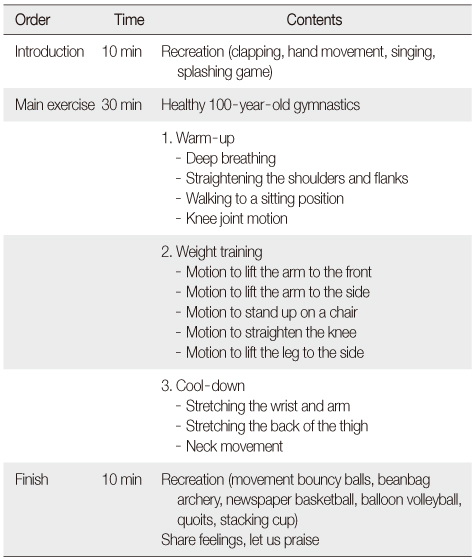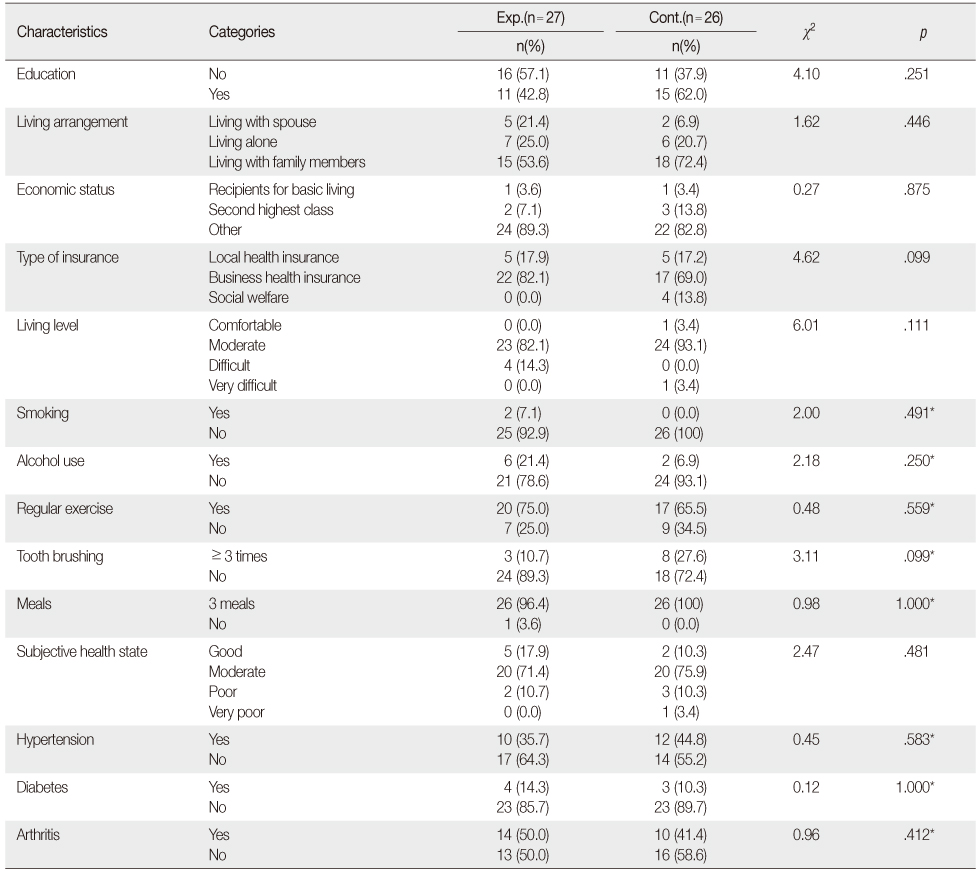Articles
- Page Path
- HOME > J Korean Acad Nurs > Volume 42(6); 2012 > Article
-
Original Article
- Effects of a Recreational Combination Gymnastics Program for Old-old Women
- Yeon Hee Choi, Choon Ji Lee
-
Journal of Korean Academy of Nursing 2012;42(6):843-852.
DOI: https://doi.org/10.4040/jkan.2012.42.6.843
Published online: December 31, 2012
1College of Nursing, Kyungpook National University, Daegu, Korea.
2Department of Nursing, Suseong College, Daegu, Korea.
- Address reprint requests to: Lee, Choon Ji. Department of Nursing, Suseong College, 15, Dalgubeoldaero-528gil, Suseong-gu, Daegue 706-711, Korea. Tel: +82-53-749-7354, Fax: +82-53-749-7240, ji0297@naver.com
© 2012 Korean Society of Nursing Science
- 730 Views
- 11 Download
- 4 Crossref
Abstract
-
Purpose
- In this study a recreational combination gymnastics program was provided for women 75 years of age or older and the effects on physical fitness (grip strength, static balance, ability to do complex movement), depression, cognitive function and quality of life were examined.
-
Methods
- A quasi-experimental study employing a nonequivalent control group, pre-post design was conducted. Participants included 53 women elders whose cognitive function was within the normal range. The women were assigned to an experimental group (27) or a control group (26). The intervention was conducted twice a week for a period of 12 weeks. Chi-square test, t-test, paired t-test, Wilcoxon rank sum test and Wilcoxon signed rank test were used for data analysis.
-
Results
- Following completion of the program, left grip strength (t=2.17, p=.035), right grip strength (t=2.04, p=.046), static balance (t=-2.18, p=.030), depression (z=-2.88, p=.004), cognitive function (t=3.96, p<.001), and quality of life (t=-3.19, p=.002) were significantly better in the experimental group.
-
Conclusion
- Findings from this study indicate that recreational combination gymnastics programs are effective in enhancing physical fitness, cognitive function, and quality of life and in decreasing depression for female elders and could therefore be regarded as positive programs for promotion of physical and mental health for older women.
- 1. American College of Sports Medicine. Clinical Professor, Department of National Council of Health and Exercise. ACSM's guidelines for exercise testing and prescription. 2011;8th ed. Seoul, Hanmibook. (Original work published 2010).
- 2. Chang CM. A structural model for falls and quality of life in elderly people living at home. 2005;Seoul, Kyung Hee University. Unpublished doctoral dissertation.
- 3. Choi EJ. Effects of rehabilitation program based on self-efficacy on poststroke patients. 2002;Seoul, Seoul National University. Unpublished doctoral dissertation.
- 4. Gatz JL, Tyas SL, St John P, Montgomery P. Do depressive symptoms predict Alzheimers disease and dementia? J Gerontol A Biol Sci Med Sci. 2005;60:744–747. http://dx.doi.org/10.1093/gerona/60.6.744.ArticlePubMed
- 5. Han KS. The effects of exercise program for physical fitness, mental health and cognitive function in the elderly. 2006;Seoul, Sangmyung University. Unpublished doctoral dissertation.
- 6. Han YR, Song MS, Lim JY. The effects of a cognitive enhancement group training program for community-dwelling elders. J Korean Acad Nurs. 2010;40:724–735. http://dx.doi.org/10.4040/jkan.2010.40.5.724.ArticlePubMed
- 7. Han YS, Choi JH. Effects of recreation combined exercise program on physical strength for elderly women. J Korean Gerontol Soc. 2008;28:941–952.
- 8. Haver D. Health promotion and aging: Practitional application for health professionals. 2010;New York, Springer Publishing Company, Inc.
- 9. Jeon EY, Kim SY, Yoo HS. Effects of music therapy and rhythmic exercise on quality of life, blood pressure and upper extremity muscle strength in institution dwelling elderly women. J Korean Acad Nurs. 2009;39:829–839. http://dx.doi.org/10.4040/jkan.2009.39.6.829.ArticlePubMed
- 10. Jeong GY. Understanding of silver life. 2003;Seoul, Hakmoonsa.
- 11. Jun JG, Lee WL, Park HG, Yoon AR, Jeong SH, Lee YR. Effects of water exercise program for 24 weeks on the body composition, health related fitness and quality of life in elders. J Korean Acad Kinesiol. 2010;12(3):25–33.
- 12. Kee BS. A preliminary study for the standardization of geriatric depression scale short form Korea version. J Korean Neuropsychiatr Assoc. 1996;35:298–307.
- 13. Kim HR, Oh KS, Oh KO, Lee SO, Lee SJ, Kim JA, et al. Quality of life in low income Korean aged. J Korean Acad Nurs. 2008;38:694–703. http://dx.doi.org/10.4040/jkan.2008.38.5.694.ArticlePubMed
- 14. Kim MK, Choi SM. The effect of the regular dance sports program on physiological function, mental health and perceived health state in older women. J Coaching Dev. 2004;6(3):281–290.
- 15. Kim MR. The study of comparing the factors of affecting on the quality of life for young-old women and old-old women. Korean J Soc Welf. 2006;58(2):197–222.
- 16. Kim SM, Lee YJ, Kim HJ. Effect of resistance training on joint flexibility and muscle strength of upper extremities of elderly with impaired cognition. J Korean Gerontol Soc. 2009;29:987–1000.
- 17. Kraemer WJ, Mazzetti SA, Ratamess NA, Fleck SJ. Brown LE. Specificity of training modes. In: Isokinetics in human performance. 2000;Champaign, IL, Human Kinetics. 25–41.
- 18. Lee JH, Lee KU, Lee DY, Kim KW, Jhoo JH, Kim JH, et al. Development of the Korean version of the consortium to establish a registry for Alzheimer's disease assessment packet (CERAD-K): Clinical and neuropsychological assessment batteries. J Gerontol B Psychol Sci Soc Sci. 2002;57:P47–P53. http://dx.doi.org/10.1093/geronb/57.1.P47.ArticlePubMed
- 19. Liu MR, So HY. Effects of tai chi exercise program on physical fitness, fall related perception and health status in institutionalized elders. J Korean Acad Nurs. 2008;38:620–628. http://dx.doi.org/10.4040/jkan.2008.38.4.620.Article
- 20. Mathias S, Nayak US, Issacs B. Balance in elderly patients: The "get-up and go" test. Arch Phys Med Rehabil. 1986;67:387–389.PubMed
- 21. Ministry of Health and Welfare. Healthy 100 years old, one, two, three. 2007;Seoul, Author.
- 22. Ministry of Health and Welfare. 2008 Customized visiting health service guidebook. 2008;Retrieved December 27, 2011. from http://www.mw.go.kr/front/index.jsp.
- 23. Moon MJ. Factors influencing depression in elderly people living at home. J Korean Acad Nurs. 2010;40:542–550. http://dx.doi.org/10.4040/jkan.2010.40.4.542.ArticlePubMed
- 24. National Statistic Organization Office. Korean statistical information service. 2010;Retrieved December 26, 2011. from http://kosis.kr/themes/themes_03List.jsp#jsClick.
- 25. Oh YS. Effects of exercise training on physical fitness and cognitive functioning in elderly. Korean J Sports Sci. 2008;17:517–526.
- 26. Roth CL. How to protect the aging work force. Occup Hazard. 2005;67:52–54.
- 27. Sheikh JI, Yesavage JA. Brink TL. Geriatric depression scale (GDS): Recent evidence and development of a shorter version. In: Clinical gerontology: A guide to assessment and intervention. 1986;New York, The Haworth Press. 165–173.
- 28. Song MS. Effects of recreation combined exercise program in body composition, physical fitness and depression in elderly. J Korean Biol Nurs Sci. 2010;12:157–165.
- 29. Yoo IY. Effects of fall prevention program applying HSEP on physical balance and gait, leg strength, fear of falling and falls efficacy of community-dwelling elderly. J Korean Gerontol Soc. 2009;29:259–273.
REFERENCES
Figure & Data
REFERENCES
Citations

- Effects of Health Gymnastics Combined with Squat on Physical Fitness and Balance Ability in Elderly Women
Mo-Beom Jeong
Journal of The Korean Society of Physical Medicine.2025; 20(1): 83. CrossRef - The effects of senior brain health exercise program on basic physical fitness, cognitive function and BDNF of elderly women - a feasibility study
Jung-Eun Byun, Eun-Bum Kang
Journal of Exercise Nutrition & Biochemistry.2016; 20(2): 8. CrossRef - Effects of the Brain waves according to participation in Therapeutic recreation programs on the Depression, Sleep Disturbance and Quality of Life in the Elderly with Dementia
Moon-Sook Lee, Byung-Jun Cho
Journal of the Korea Academia-Industrial cooperation Society.2015; 16(8): 5096. CrossRef - Physical benefits and reduction of depressive symptoms among the elderly: Results from the Portuguese "National Walking Program"
Jeronimo Costa Branco, Karen Jansen, Jessica Teixeira Sobrinho, Susana Carrapatoso, Barbara Spessato, Joana Carvalho, Jorge Mota, Ricardo Azevedo da Silva
Ciência & Saúde Coletiva.2015; 20(3): 789. CrossRef
Recreational Combination Gymnastics Program
Homogeneity of General Characteristics of the Groups (N=53)
Exp.=Experimental group; Cont.=Control group.
*Fisher's exact test.
Homogeneity Test for Dependent Variables (N=53)
Exp.=Experimental group; Cont.=Control group.
*Mann-Whitney test.
Difference between Groups in Physical Fitness (N=53)
Exp.=Experimental group; Cont.=Control group; ta=Paired test; tb=Independent test.
*Wilcoxon signed rank test; †Mann-Whitney test.
Difference between Groups in Depression, Cognition and Quality of Life (N=53)
Exp.=Experimental group; Cont.=Control group; ta=Paired test; tb=Independent test.
*Wilcoxon signed rank test; †Mann-Whitney test.
Exp.=Experimental group; Cont.=Control group. *Fisher's exact test.
Exp.=Experimental group; Cont.=Control group. *Mann-Whitney test.
Exp.=Experimental group; Cont.=Control group; ta=Paired test; tb=Independent test. *Wilcoxon signed rank test; †Mann-Whitney test.
Exp.=Experimental group; Cont.=Control group; ta=Paired test; tb=Independent test. *Wilcoxon signed rank test; †Mann-Whitney test.
 KSNS
KSNS
 E-SUBMISSION
E-SUBMISSION





 Cite
Cite

